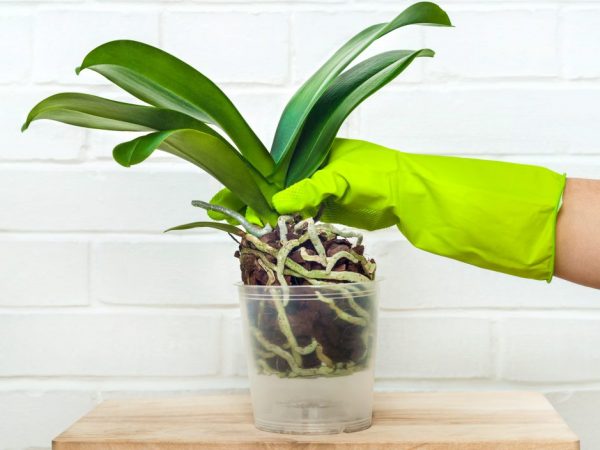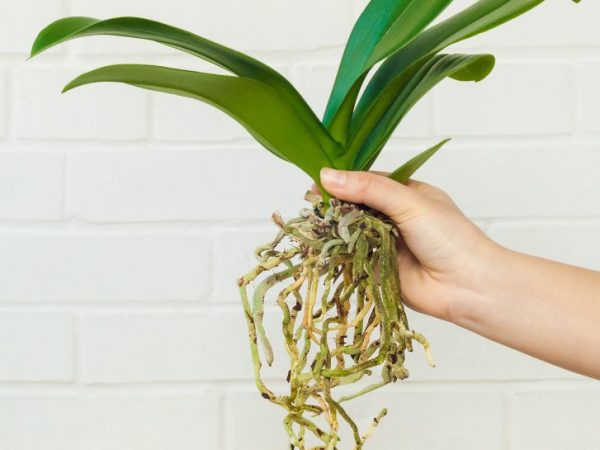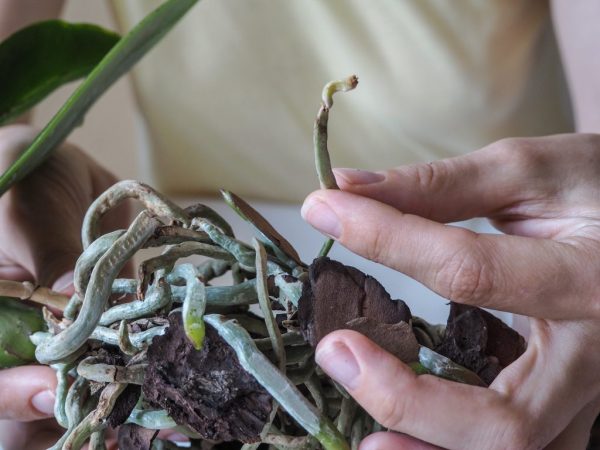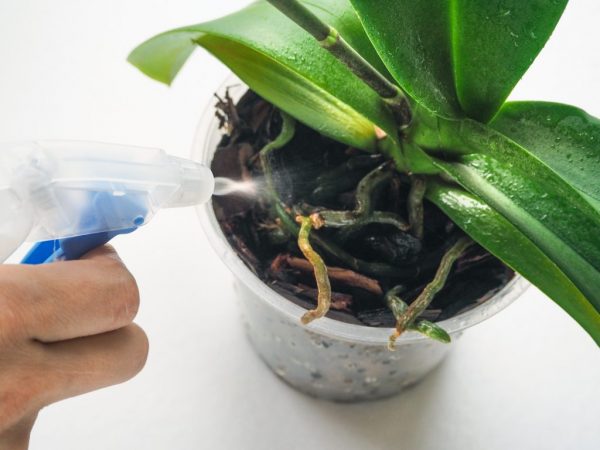The use of succinic acid for orchids
Growing orchids is accompanied by a number of difficulties, so it is so important not to harm the plant. Succinic acid for orchids is a universal feed that helps to solve all problems.
- Indications for using the product
- The composition of the tablet
- Dilution of the drug
- Rules and methods of application
- Leaf processing
- Seed treatment
- Root restoration
- Extending the flowering period
- Root treatment before transplanting a flower
- Watering
- Preparation of complex solutions
- The harm of the drug
- Precautions
- Conclusion

The use of succinic acid for orchids
Indications for using the product
The useful composition of this product allows you to quickly and efficiently regenerate the roots and leaves of a flower, as well as normalize its nutrition. With this drug, there is a chance:
- extend the flowering period of Orchids;
- activate the process of active rooting of cut cuttings;
- stimulate root formation;
- accelerate the regeneration processes;
- increase the flower's immunity to diseases and poor living conditions;
- build up the deciduous mass of the plant.
Succinic acid for orchids is also a good antiseptic, so its effect, if used correctly, extends to the soil that contains the flower. With the help of the active substances of the drug, microorganisms harmful to the plant contained in the soil are destroyed.
The composition of the tablet
The drug is a product of amber processing. The product is of natural origin and its use is not harmful to the human body and plants. The substance has the appearance of a white crystalline fine powder. In pharmacological form, these are tablets or powder.
The preparation contains 100 mg of acetylominosuccinic acid, which is the active ingredient. Also, such a product is rich in magnesium, zinc, iron, copper, etc.
Dilution of the drug
Diluting succinic acid for orchids should be strictly proportioned. Dilute 1 tablet in 250 ml of water. The tablet is pounded in the package. The resulting powder is dissolved in 1000-1500 ml of hot water. Add warm water to the required volume.
Use a solution at room temperature or warm. It is allowed to be stored only in a dark place and using glass containers. The maximum shelf life is 3 days. The unsuitability of its use is determined by the appearance of white lumps in the liquid.
Rules and methods of application

Processing leaves and roots
The main advantage of treating orchids with succinic acid is the high efficiency of the preparation, as well as its versatility. It is used as a fertilizer for healthy flowers at all stages of orchid growth and as a root growth stimulant. This remedy helps prevent the appearance of diseases and pests. Leaves, roots, seeds, cuttings are treated with it.
It is an ideal biostimulant that can be used in several ways. The main thing is to take into account the proportions and follow the appropriate recommendations.
Leaf processing
In floriculture, the most effective way is to wipe the leaves.Orchid leaves should be wiped with succinic acid if they shriveled or become lethargic. It is important to restore turgor: it is an indicator of the state of the plant. You need to process it with a solution, for this 1 tablet should be diluted in 250 ml of water.
The foliage is processed daily in the morning using soft materials (cosmetic discs, a piece of natural fabric, etc.). Avoid getting the medicine into the base of the sheet plates. After use, the effect of the drug lasts for 1-2 days. When the turgor returns, the solution is washed off with a wet rag or napkin.
Seed treatment
The use of succinic acid for orchids also lies in the germination of seedlings from seeds. Stimulating growth is often a necessary activity that increases the chances of producing healthy and strong young flowers.
The use of succinic acid for orchids (its seeds) requires the preparation of a solution. 1 tablet is dissolved in 240 ml of water, the seeds are soaked for 12 hours. After drying them, they proceed to sowing. Such an operation is necessary for flower growers who want to breed a crop at home.
Root restoration
The result of diseases and poor quality flower care at home is a partial loss of roots. The flower is reanimated using a concentrated product. The drug in tablets is diluted in water in a proportion of 4 tablets / 1 liter. The damaged flower is sprayed with a spray bottle. The plant is processed daily in the morning.
Do not be afraid of harming the orchid with an overdose. The use of such a remedy when building up roots has no drawbacks. The flower takes as much medicine as it needs. To increase efficiency, before each spraying procedure, the leaves of a diseased orchid are wiped with a damp cloth.
Resuscitation of the root shoots of the plant is carried out by another method. Dilute the same solution of succinic acid for orchids (4 tablets / 1 liter of warm water), soak the damaged flower in it. Plant resuscitation is performed according to the instructions:
- The plant is placed in the solution so that only the socket is treated.
- Processing is carried out within 2-3 months at the main growing site. Take into account the indicators of room temperature and humidity.
- As the medicine evaporates and is absorbed by the plant, the solution is poured into the pot.
This method is effective for complete loss of plant roots. When used correctly, roots are formed within 30-40 days. The procedure for keeping the orchid in succinic acid is stopped with the appearance of shoots more than 5 cm long. Then it is transplanted to a permanent place.
Extending the flowering period

Orchid feeding is a must
Fertilizing orchids with succinic acid is also beneficial for the inflorescences of the plant. Often the indication for use is the wilting of the bush. The use of the drug promotes an increase in flowering shoots 2-3 times. Spraying method is used. The standard solution is diluted before use. The main thing is to take into account some features:
- The use of fertilizer to stimulate flowering is effective only for healthy plants with 3-5 leaves.
- Spraying is carried out in a place familiar to a flower at a room temperature of 20-22 ° C, moderate air humidity and in a well-lit place.
- Spraying is repeated with active growth, flowering. Re-fertilizing indoor flowers is required when the arrow reaches 10 cm.
The third spraying is carried out when the first flowering opens. It gives the flower an abundance of nutrients to prolong the flowering period, and also helps to increase the size of the blooms. Florists do not recommend beginners to start using this method. Any mistake negatively affects the health of the plant, depriving it of buds. They can crumble, and the nutrients that were obtained with the solution can be spent on the growth of the root system and leaves.
Root treatment before transplanting a flower
Succinic acid for Phalaenopsis and other Orchid species is also used to stimulate the root system before transplanting a flower. It is required to prepare a solution of 4 tablets per 1 liter of water and place a flower in it. The holding time depends on the condition of the plant. A healthy flower needs 30 minutes. Flabby flowers can stand for 2-2.5 hours.
Dry the roots before transplanting. This procedure makes the plant stronger. The effect is observed after 7-10 days. New shoots appear on the peduncles.
Watering
It will be useful to use succinic acid for orchids in the form of additional feeding. The use of this remedy has a beneficial effect on the roots of the flower, stimulating their active growth, forming a strong immunity to diseases and pests. Using the product in tablets, it is necessary to prepare a standard solution (1 g of substance per 1 liter of water).
Having poured the prepared solution into a watering can or a bottle, they start feeding. The plant is gently watered at the root. The volume of liquid fertilizer is determined by the size of the pot. Watering is stopped as soon as water begins to flow from the drainage holes. After waiting for it to drain into the pan, it is poured out to avoid rotting the roots of the plant.
Watering also has its own characteristics. When watering flowers with such a biostimulant, it is important to take into account the periods of intense flower growth, therefore it is watered only in spring and summer. In autumn and winter, the flower is easy to harm. Additional stimulation during dormancy often leads to impaired root development and root rot.
Preparation of complex solutions

Spray with a solution with succinic acid
It is permissible to use complex solutions that feed flowers with useful microelements. The most widespread are:
- Tonic. In 1 liter of water dissolve 2 tablets of succinic acid and 1 ampoule of glucose, vitamin PP, ascorbic acid, vitamin B12 and pyridoxine. Such a solution is suitable for both watering and spraying, and for wiping the leaves. The flower is processed once a day in the morning or in the evening.
- Cocktail. The solution is prepared from preparations in tablets: succinic acid (2 pcs.), Nicotinic acid (1/2 pcs.), "Thiamin" (1/2 pcs.), "Pyridoxine" (1/2 pcs.), "Cyanocobalamin" ( 1/2 pcs.). The tablets are crushed and added to 1 liter of water. It is also important to add Kornevin (on the tip of a knife).
- Mix with garlic. 6 cloves of garlic are infused in 0.5 liters of warm water. After 12 hours, the agent is filtered and mixed with an aqueous fertilizer solution (0.5 l). The resulting volume is diluted to 4 liters and used for irrigation 1-2 times a month.
Thanks to the additional nutrients included in the complex products, it is easy to restore the health of the plant, to activate its growth and even flowering.
The harm of the drug
Having decided to save the flower from death, flower growers often forget about simple recommendations for the use of the drug. Spray, water or keep the flower strictly at a favorable time for this. The product should be used in accordance with the recommended concentration.
For preventive purposes, the flower is treated every 30-60 days. In winter and autumn, you should not start such events. During the flowering period, succinic acid should be used with caution. Any mistake leads to shedding of flowering, and all the forces of the plant are distributed to the formation of the root system and leaves of the flower.
Precautions
Watering decorative orchids with succinic acid requires special safety rules.
A natural biostimulant in the dosage form of tablets makes orchids stronger and more beautiful. It is completely safe for the flower and is perceived by it as a food product. It is not harmful to humans either, but if it gets on the skin or mucous membranes, it causes an allergic reaction.
Gloves should be worn to avoid acid contact with skin. To protect the mucous membrane of the mouth and nose - a gauze bandage. This drug is not toxic.The only danger is contact with the eyes (irritation of the eye shell appears).
If the solution comes into contact with the skin or eyes, rinse them with water. It is important to see a doctor if necessary.
Conclusion
In the care of indoor flowers, succinic acid is often used, and decorative orchids are no exception. With the help of this drug, there is a chance to revive the plant after loss of roots, increase immunity to diseases and even increase the duration of flowering. The use of the drug is universal. The plant is sprayed with the solution made, watered, wiped the leaves and used as a liquid stimulating basis for the formation of root shoots (keeping in solution).
It is important to adhere to the basic rules for using such a tool. It will be beneficial only if the proportions are observed and the time of use is favorable.


